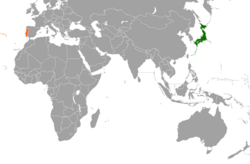日本—葡萄牙關係
 | |
日本 |
葡萄牙 |
|---|---|
日本-葡萄牙關係(日語:日本とポルトガル関係;葡萄牙語:Relações entre Japão e Portugal)描述的是日本與葡萄牙之間的外交關係。雖然葡萄牙水手於1543年第一次訪問了日本,但兩國的外交關係始於19世紀。
歷史
[編輯]鎖國時期
[編輯]

1543年,葡萄牙人是第一批到達日本的歐洲人,葡萄牙與日本的第一次聯繫就在日本南部的群島上,因此這段時期通常被稱為南蠻貿易,當時歐洲人和亞洲人都奉行重商主義。葡萄牙人在這個時候發現了長崎港,並在1571年通過耶穌會士加斯帕·維拉邀請當地的大名大村純忠皈依了天主教。
商業的擴張擴大了葡萄牙人在日本的影響力,尤其是在九州的影響力,在1578年葡萄牙人擊退了龍造寺氏對港口的進攻後,九州成為了戰略要地。
在日本靠岸的第一批葡萄牙船隻運載的基本上是來自中國的貨物(絲綢、瓷器等)。日本人渴求這些貨物,但是天皇禁止民眾與中國人接觸,目的是為了懲罰倭寇海盜的襲擊。因此,葡萄牙人在亞洲貿易中充當中間人。
1592年,葡萄牙與日本的貿易開始受到越來越多的中國走私者的挑戰,還有1600年占領馬尼拉的西班牙的船隻,1609年的荷蘭船隻和1613年的英國船隻。
日本人感興趣的很多東西之一就是葡萄牙製造的火繩槍。1543年最先到達日本的三個歐洲人是葡萄牙商人安東尼奧·莫塔、弗朗西斯科·澤莫托和安東尼奧·佩伊托(也可能是費爾諾·門德斯·平托)。他們到達了種子島的南端,在那裡他們將向當地人介紹火繩槍。由於日本正處於被稱為戰國時代的內戰時期,火繩槍一下子吸引了日本各地的大名。著名的大名織田信長就曾大量購置火繩槍,並運用在後來的長篠之戰,從此改變騎兵在日本戰場上的強勢地位。在火繩槍傳入的一年內,日本鐵匠就掌握了火繩槍的製造技術,並開始大量生產。後來,火繩槍製造技術得到了改進,日本火繩槍的品質也提高了。與中國在這一時期的火器試驗一樣,日本人開發了更好的瞄準鏡和繩索保護裝置。僅僅50年後,日本的軍隊裝備的火繩槍數量可能比歐洲任何一支同時代軍隊都多。這些武器在豐臣秀吉和德川家康領導下的日本統一,以及1592年和1597年入侵朝鮮的戰爭中發揮了極其重要的作用。歐洲人帶來的貿易不僅有火繩槍,還有肥皂、煙草和其他在封建日本不為人知的產品。
1543年,葡萄牙人第一次與日本接觸後,一場大規模的奴隸貿易開始了。在16世紀和17世紀,葡萄牙人在日本購買日本人作為奴隸,並把他們賣到海外的各個地方,包括葡萄牙本土。[1][2]許多文件提到了大規模的奴隸貿易,以及反對奴役日本人的抗議活動。1555年,教會指出,日本奴隸被認為是第一批來到歐洲的日本人,葡萄牙人購買了大量日本女奴,帶到葡萄牙進行性交易。塞巴斯蒂安國王擔心這會對天主教的福音傳播產生負面影響,因為日本的奴隸貿易已經發展到相當大的規模,所以他在1571年下令禁止奴隸貿易。[3][4]
1598年,葡萄牙耶穌會士路易斯•塞奎拉在一份文件中提到,日本女奴甚至被當作小妾賣到葡萄牙船上,在日本從事交易。[5]葡萄牙人把日本奴隸帶到澳門,其中一些人不僅淪為葡萄牙人的奴隸,還淪為其他奴隸的奴隸,葡萄牙人擁有馬來人和非洲人的奴隸,而這些人又擁有自己的日本奴隸。[6][7]
豐臣秀吉非常厭惡自己的日本人在九州被賣為奴隸,於是他在1587年7月24日給耶穌會副會長加斯帕•科埃略寫了一封信,要求葡萄牙人、暹羅人(泰國人)和柬埔寨人停止購買和奴役日本人,並歸還遠至印度的日本奴隸。[8][9][10]豐臣秀吉譴責葡萄牙人和耶穌會士販賣奴隸,並因此禁止基督教的福音傳播。[11][12]
許多朝鮮奴隸被葡萄牙人買走並從日本帶回葡萄牙,在日本入侵朝鮮期間,他們是被流放到日本的數萬朝鮮戰俘的一部分。[13][14]歷史學家指出,豐臣秀吉一方面對葡萄牙販賣日本奴隸表示憤慨和義憤,另一方面自己卻在日本大規模販賣朝鮮戰俘。[15][16]
1578年,著名旅行家和商人菲力波·薩塞蒂在里斯本的奴隸社區中發現了一些中國和日本的奴隸。[17][18][19][20][21]
葡萄牙人「高度重視」像中國人和日本人一樣的亞洲奴隸,比「撒哈拉以南非洲的奴隸」更加重視。[22][23]葡萄牙人認為中國人和日本人的奴隸具有聰明勤奮等品質,這也是葡萄牙人更喜歡他們的原因。[24][25][26][27]
1595年,葡萄牙通過了一項法律,禁止買賣中國和日本的奴隸。[28]
1587年豐臣秀吉下達了禁教令,葡萄牙收到了宣告傳教士撤離和終止貿易自由的文書。進入江戶時代後,德川家康沿襲了這一政策(1614年的基督教禁止令)。在家康的晚年,葡萄牙人的停泊地被限制在平戶市和長崎。1620年發生平山常陳事件,幕府對基督教的不信任達到了決定性的地步,幕府切斷了與當時伊比利聯盟的關係,並要求澳門的傳教士不能前往日本。
但是,傳教士仍然沒有放棄對日本的傳教。 他決定前往東南亞的一個日本人云集的小鎮,在那裡日本、西班牙和葡萄牙的主權已遙不可及,可以不受管制地向日本人傳教,並使用朱印船將基督徒送回日本。 一些傳教士偽裝成商人或水手,並用朱印船進入日本。
語言
[編輯]由於葡萄牙人來到日本,亞洲和歐洲之間的貿易不斷湧入,日本詞彙吸收了葡萄牙語起源的詞彙變成了新的日語詞彙。這些詞主要包括葡萄牙產品和習俗,通過葡萄牙商人到達而傳播。
葡萄牙語是第一個擁有日語詞典的西方語言,即日葡辭書,由耶穌會士若昂·羅德里格等人編撰,於1603年在長崎出版。
常駐外交使團
[編輯]-
日本駐里斯本大使館
-
葡萄牙駐東京大使館
參考文獻
[編輯]- ^ HOFFMAN, MICHAEL. The rarely, if ever, told story of Japanese sold as slaves by Portuguese traders. The Japan Times. May 26, 2013 [2014-03-02]. (原始內容存檔於2019-05-05).
- ^ Europeans had Japanese slaves, in case you didn't know…. Japan Probe. May 10, 2007 [2014-03-02]. (原始內容存檔於March 4, 2016).
- ^ Nelson, Thomas. Monumenta Nipponica (Slavery in Medieval Japan). Monumenta Nipponica (Sophia University.). Winter 2004, 59 (4): 463–492. JSTOR 25066328.
- ^ Monumenta Nipponica: Studies on Japanese Culture, Past and Present, Volume 59, Issues 3-4. Jōchi Daigaku. Sophia University. 2004: 463 [2014-02-02].
- ^ Michael Weiner (編). Race, Ethnicity and Migration in Modern Japan: Imagined and imaginary minorites illustrated. Taylor & Francis. 2004: 408 [2014-02-02]. ISBN 0415208572.
- ^ Kwame Anthony Appiah, Henry Louis Gates, Jr. (編). Africana: The Encyclopedia of the African and African American Experience illustrated. Oxford University Press. 2005: 479 [2014-02-02]. ISBN 0195170555.
- ^ Anthony Appiah, Henry Louis Gates (編). Encyclopedia of Africa, Volume 1 illustrated. Oxford University Press. 2010: 187 [2014-02-02]. ISBN 978-0195337709.
- ^ Monumenta Nipponica. Jōchi Daigaku. Sophia University. 2004: 465 [2014-02-02].
- ^ Joseph Mitsuo Kitagawa. Religion in Japanese History illustrated, reprint. Columbia University Press. 2013: 144 [2014-02-02]. ISBN 978-0231515092. (原始內容存檔於2020-04-14).
- ^ Donald Calman. Nature and Origins of Japanese Imperialism. Routledge. 2013: 37 [2014-02-02]. ISBN 978-1134918430. (原始內容存檔於2020-04-14).
- ^ Gopal Kshetry. FOREIGNERS IN JAPAN: A Historical Perspective. Xlibris Corporation. 2008 [2014-02-02]. ISBN 978-1469102443. (原始內容存檔於2020-03-17).[自述來源]
- ^ J F Moran, J. F. Moran. Japanese and the Jesuits. Routledge. 2012 [2014-02-02]. ISBN 978-1134881123. (原始內容存檔於2020-04-14).
- ^ Robert Gellately, Ben Kiernan (編). The Specter of Genocide: Mass Murder in Historical Perspective reprint. Cambridge University Press. 2003: 277 [2014-02-02]. ISBN 0521527503. (原始內容存檔於2020-04-14).
- ^ Gavan McCormack. Reflections on Modern Japanese History in the Context of the Concept of "genocide". Edwin O. Reischauer Institute of Japanese Studies. Harvard University, Edwin O. Reischauer Institute of Japanese Studies. 2001: 18 [2014-02-02]. (原始內容存檔於2020-04-14).
|issue=被忽略 (幫助) - ^ Olof G. Lidin. Tanegashima - The Arrival of Europe in Japan. Routledge. 2002: 170 [2014-02-02]. ISBN 1135788715.
- ^ Amy Stanley. Selling Women: Prostitution, Markets, and the Household in Early Modern Japan. Volume 21 of Asia: Local Studies / Global Themes. Matthew H. Sommer. University of California Press. 2012 [2014-02-02]. ISBN 978-0520952386.
- ^ Jonathan D. Spence. The memory palace of Matteo Ricci illustrated, reprint. Penguin Books. 1985: 208 [2012-05-05]. ISBN 0140080988. (原始內容存檔於2020-04-14).
countryside.16 Slaves were everywhere in Lisbon, according to the Florentine merchant Filippo Sassetti, who was also living in the city during 1578. Black slaves were the most numerous, but there were also a scattering of Chinese
- ^ José Roberto Teixeira Leite. A China no Brasil: influências, marcas, ecos e sobrevivências chinesas na sociedade e na arte brasileiras. UNICAMP. Universidade Estadual de Campinas. 1999: 19 [2012-05-05]. ISBN 8526804367. (原始內容存檔於2020-04-14) (葡萄牙語).
Idéias e costumes da China podem ter-nos chegado também através de escravos chineses, de uns poucos dos quais sabe-se da presença no Brasil de começos do Setecentos.17 Mas não deve ter sido através desses raros infelizes que a influência chinesa nos atingiu, mesmo porque escravos chineses (e também japoneses) já existiam aos montes em Lisboa por volta de 1578, quando Filippo Sassetti visitou a cidade,18 apenas suplantados em número pelos africanos. Parece aliás que aos últimos cabia o trabalho pesado, ficando reservadas aos chins tarefas e funções mais amenas, inclusive a de em certos casos secretariar autoridades civis, religiosas e militares.
- ^ Jeanette Pinto. Slavery in Portuguese India, 1510-1842. Himalaya Pub. House. 1992: 18 [2012-05-05]. (原始內容存檔於2020-04-14).
ing Chinese as slaves, since they are found to be very loyal, intelligent and hard working' . . . their culinary bent was also evidently appreciated. The Florentine traveller Fillippo Sassetti, recording his impressions of Lisbon's enormous slave population circa 1580, states that the majority of the Chinese there were employed as cooks.
- ^ Charles Ralph Boxer. Fidalgos in the Far East 1550-1770 2, illustrated, reprint. 2, illustrated, reprint. 1968: 225 [2012-05-05]. (原始內容存檔於2020-04-14).
be very loyal, intelligent, and hard-working. Their culinary bent (not for nothing is Chinese cooking regarded as the Asiatic equivalent to French cooking in Europe) was evidently appreciated. The Florentine traveller Filipe Sassetti recording his impressions of Lisbon's enormous slave population circa 1580, states that the majority of the Chinese there were employed as cooks. Dr. John Fryer, who gives us an interesting ...
- ^ José Roberto Teixeira Leite. A China No Brasil: Influencias, Marcas, Ecos E Sobrevivencias Chinesas Na Sociedade E Na Arte Brasileiras. UNICAMP. Universidade Estadual de Campinas. 1999: 19 [2014-02-02]. ISBN 8526804367 (葡萄牙語).
- ^ Paul Finkelman. Paul Finkelman, Joseph Calder Miller , 編. Macmillan encyclopedia of world slavery, Volume 2. Macmillan Reference USA, Simon & Schuster Macmillan. 1998: 737 [2014-02-02]. ISBN 0028647815. (原始內容存檔於2020-04-14).
- ^ Finkelman & Miller 1998,第737頁
- ^ Duarte de Sande. Derek Massarella , 編. Japanese Travellers in Sixteenth-century Europe: A Dialogue Concerning the Mission of the Japanese Ambassadors to the Roman Curia (1590). Volume 25 of 3: Works, Hakluyt Society Hakluyt Society. Ashgate Publishing, Ltd. 2012 [2014-02-02]. ISBN 978-1409472230. ISSN 0072-9396. (原始內容存檔於2020-03-17).
|issue=被忽略 (幫助) - ^ A. C. de C. M. Saunders. A Social History of Black Slaves and Freedmen in Portugal, 1441-1555. Volume 25 of 3: Works, Hakluyt Society Hakluyt Society illustrated. Cambridge University Press. 1982: 168 [2014-02-02]. ISBN 0521231507. (原始內容存檔於2021-08-07).
- ^ Jeanette Pinto. Slavery in Portuguese India, 1510-1842. Himalaya Pub. House. 1992: 18 [2014-02-02].
- ^ Charles Ralph Boxer. Fidalgos in the Far East 1550-1770 2, illustrated, reprint. Oxford U.P. 1968: 225 [2014-02-02].
- ^ Dias 2007,第71頁




